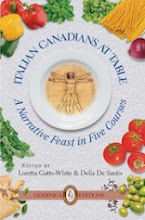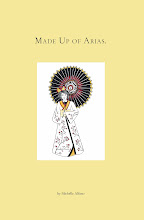
What the
(fill in the expletive of your choosing) am I doing here? I wondered as I drove up to
Gilmour Hall at
McMaster University. I had been invited to read a piece at a conference entitled
“Italian Canadian Culture in the New Millennium” on a beautiful day in early November, organized by a trio of professors at
McMaster in the Department of Linguistics and Languages .
One of the organizers, Asst. Prof. Paolo
Chirumbolo (surprisingly young and “hot”, I noted to myself unprofessionally as I was introduced to him), had read an essay that I had written in an anthology of writers of Sicilian descent three years ago called
Sweet Lemons: Writings With a Sicilian Accent and invited me to speak.
Many of the speakers were academics or had Ph.D.s and now have prominence in the cultural and business communities: the Italian Cultural Institute, the CBC, the Italian Chamber of Commerce Toronto. Then there is me, a lowly writer whose only claim to fame is a modest publishing CV and
an acerbic blog where I give vent to my odd obsessions. I felt like an
imposter at the ball …
I looked around the room and, reassuringly, I recognized a few faces. But, sadly as well, my thoughts echo the rebellious murmurings of my old friend
CP, a poet, who has also been invited to read. He wondered,
Dove la gioventu? (Where are the young people?) There were a sprinkling of fresh faced undergrads near the front sitting together and later acknowledged as Prof. Paolo’s students (of course). Another friend, the writer VF, wondered if we were only speaking to ourselves. This is a recurring theme at these conferences.
CP’s annoyance might have something to do with being positioned next to last in the reading lineup (lowly writer,
me, is last, of course). Self consciously, I wondered if it was because I lacked the requisite initials after my name, no M.A., no Ph.D., and no elaborate treatise to read with a title like “Whither the hyphen in
Italo-Canadian culture?” (this is a
made up subject but indicative of what is read at conferences like this).
The first presentation was an astute, if
longwinded, hour long dissertation by DP, dubbed "the the colourful former head of arts and entertainment at CBC Radio", on the use of the hyphen and its disappearance with the success of
Italo-Canadian artists such as
Nino Ricci, Antoni Cimolini or
Richard Monette (who is half Italian, who knew?).
The other presenters tackled worrisome issues pertinent to the community. The words “cognitive ethnicity”, “invisible minority”, “metalinguistic”, “meta-histories”, "cultural data” and "Sisyphean" abounded …
Oh boy, did I mention that there was also
me, reading a highly personal essay on race and identity which was mercifully short because I couldn’t bear these half hour monologues and that I was scheduled to read at
FIVE O'CLOCK at the end of the day. I told very few people because the essay is highly charged and I felt I might lack the nerve to read it.
There was the usual
Nino Ricci bashing ... "he's a sell-out, only produced one good book, the
TV series of Lives of the Saints was atrocious", blah blah blah ... this unpleasant blather is so cliche, so typical of immigrant communities with chips on our shoulders - of course, we
would attack the person who is the most successful amongst us. Especially reprehensible as I have never heard
Nino Ricci utter one negative thing about the community or other writers in general.
Some standouts:
John Calabro, writer and co-publisher of the new small press
Quattro Books, who spoke from a personal perspective. He wanted writers to pointedly reject the current sentimentality and maudlin nature of
Italo-Canadian writing (
speak truth to power John). He then read a subtly subversive piece of fiction about a son visiting his parents in
Woodbridge and provoking their anger simply by refusing a glass of homemade wine. It was a perfect metaphor for the alienation which some 2
nd generation
Italo-Canadians feel.
Something I noticed too, when the Sicilians amongst us spoke, we always mentioned that we were Sicilian,
always, in our presentations.
Other questions poised: is
Italo-Canadian writing as “good” as the writing of other Canadians? Yes, and no, the assembled panel reluctantly admitted: there is good writing and
dreck (but this is obvious, no?). The questioner seemed to think that
Italo-Canadian writing was
subpar and cited the example of a recent anthology called
Mamma Mia: Good Italian Girls Talk Back. I have not read the anthology and the title (not the content) did seem a bit
cartoonish and commercial to me at the time, as if that
stereotypical ejaculation summed up our culture.
But I was a bit shocked to learn that the editor of that anthology was seated amongst the listeners and it turns out that I know her.
FS, a playwright, opined sagely that there is much that is good and much that is not great out there but we have to start somewhere. She is right of course.
Later a prof from Wilfred
Laurier University read her piece entirely in Italian. The young girl beside me started to text and, obviously resentful because I
couldn’t follow the speech properly, I begin to write this piece on
McMaster letterhead. When the same prof
leapt up and asked for water in English, the woman across from me muttered “Why
didn’t she say
that in Italian?”
And hey, by mid afternoon, I had figured out where the
gioventu were folks ... according to a prof from York University they're on that newfangled Internet on their
Facebook pages joining groups which ask pertinent questions of other kids of Italian descent such as: recollecting favourite things your
Nonna has said, bonding with other people of mixed Italian heritage, or deriding insulting stereotypes of Italians in commercials. So as awkward and
so ten minutes ago as a presentation on "Ontario Italian
Facebook groups" sounded, it did seem to give us hope that the under 40 crowd is interested in our culture; they just manifest it in another way and in another form of media.
The conference soon (did I say soon?) drew to an end with a short film on a prayer group by SM, a charming professor of anthropology based in B.C. (quick
shout out to
Racalmuto - his father is from my parents' village in Sicily), a piece on the introduction of Italian food into Calgary in the 50s and then an entertaining presentation by my truculent friend
CP, the poet, whom I consider to be 50% brilliant, 50% full of hot air (but hey, it makes for a charming mix).
Finally at five, I read my short piece (oh yeah - thanks
CP for spilling water all over the lectern). I was nervous because it has to do with my father and race and certain unpleasant memories and I am keenly aware that people must be tired at the end of this long day. I made it through the essay, but just barely kept it together. The response was gracious, people were kind but I was disappointed by my reading. I have done better I know.
As I left, I was relieved that certain participants offered kind remarks and we traded parting comments on our mutual obsessions: our kids, the Sicilian bandit
Salvatore Giuliano about whom I have written a novel, the special difficulties for women writers, the small magazines that we are a part of. A reporter from the
Hamilton Spectator said she wanted to ask me some questions (we weren't able to connect but the article is printed
here)...
Although I felt both physically and emotionally exhausted, I am glad I came; it is important to connect with like minded people. Hey, it’s the closest I ever come to walking into a room and thinking
“These are my people.”
 Factory Girl (2007) directed by George Hickenlooper
Factory Girl (2007) directed by George Hickenlooper


 Fur: An Imaginary Portrait of Diane Arbus
Fur: An Imaginary Portrait of Diane Arbus 












